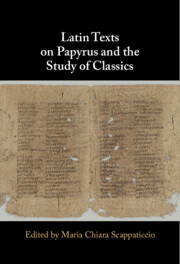Latin Texts on Papyrus and the Study of Classics
This volume gathers 25 chapters focused on Latin texts on papyrus, exploring them from multi- and cross-disciplinary perspectives. It serves as a companion to the texts published in The Corpus of Latin Texts on Papyrus (Cambridge, forthcoming). The chapters provide in-depth analyses of the chosen texts from literary, philological, linguistic, and historical perspectives, or offer methodological reflections on Latin texts on papyrus, promoting innovative approaches. They cover topics ranging from palaeography and philology to Latin literature and from ancient law to ancient and medieval history, and brilliantly demonstrate the potential of Latin texts on papyrus to inspire and illuminate the field of Classics.
Product details
December 2025Hardback
9781009586597
450 pages
244 × 170 mm
10 b/w illus.
Not yet published - available from December 2025
Table of Contents
- Latin Texts on Papyrus: A Project, Its Corpus, and the Future of Research. I. The Literary Perspective, II. The Documentary Perspective M. C. Scappaticcio and L. C. Colella
- Part I. Philological and Literary Insights:
- 1. The papyri of Terence and the Latin grammatical tradition F. Biville
- 2. Latin gnomic literature in light of P. Mich. VII 430 (= CLTP IB.20) A. S. Gitner
- 3. Medical or culinary recipes? On the technical prose of a first-century roll A. Garcea
- 4. P. Hamb. II 167 recto: drama (in prose?) C. Panayotakis
- 5. The Latin papyri from the Herculaneum library: new results and fresh perspectives T. Dorandi
- 6. Editing the Carmen de Bello Aegyptiaco for the CLTP: new results and further perspectives V. Piano
- 7. Virgilian Centos and Papyri Vergilianae P. Paolucci
- 8. 'Varus, give me back my … money!' Marginal notes on the Hadrianus S. Rocchi
- Part II. Philological and Linguistic Insights:
- 9. From Roman Egypt to the Renaissance: the evolution of the Celtis glossary (part 1) E. Dickey
- 10. From Roman Egypt to the Renaissance: the evolution of the Celtis glossary (part 2) R. Ferri
- 11. Latin in Roman soldiers' and veterans' private documents: selected case studies A. Pezzella
- 12. The relevance of the Italian papyri to the study of late Latin and the emergence of the Romance vernaculars R. Sornicola
- 13. On the Latin–Arabic bilingual papyrus, British Library inv. 3124: the 'Italian' connection G. D'Alessio
- 14. Allography in Latin ostraca (Assenamat, Gigthi, Bu Njem): linguistic analysis of Paleo-Amazigh personal names and external implications A. Bernini
- 15. Latin ostraca from Tripolitania C. Múrcia Sanchez
- Part III. Palaeographic Insights:
- 16. The Latin papyri and the history of writing, or about their contribution to the formation of a scientific vocabulary in palaeography T. De Robertis
- 17. Some reflections on the presence of accents in the Montserrat Cicero's in Catilinam ii A. Nodar
- 18. A Survey on abbreviating (and punctuation) signs in Latin documentary papyri, ostraka and tablets from Roman Africa and the East (BCE I–VII CE) G. Iovine
- 19. Rethinking the evidence for Latin shorthand in Late Antiquity and the Early Middle Ages A. Ghignoli
- Part IV. Juridical and Historical Insights:
- 20. Ancient jurists and Latin papyri F. Nasti
- 21. The contribution of the CLTP to the study of Roman justice M. Pedone
- 22. Julio-Claudian procedural reforms and imperial constitutions in the light of BGU II 611 and BGU II 628 P. Buongiorno
- 23. Marcus Aper and the ala Apriana L. Capponi
- 24. Did a fiscus barbaricus ever exist? Remarks on P.Ital. 1 (AD 445–446) D. Internullo.






